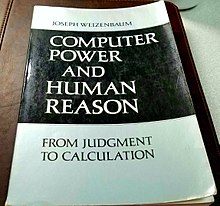Artificial intelligence (AI), in its broadest sense, is intelligence exhibited by machines, particularly computer systems, as opposed to the natural intelligence of living beings. As a field of research in computer science focusing on the automation of intelligent behavior through machine learning, it develops and studies methods and software which enable machines to perceive their environment and take actions that maximize their chances of achieving defined goals, with the aim of performing tasks typically associated with human intelligence. Such machines may be called AIs.

ELIZA is an early natural language processing computer program developed from 1964 to 1967 at MIT by Joseph Weizenbaum. Created to explore communication between humans and machines, ELIZA simulated conversation by using a pattern matching and substitution methodology that gave users an illusion of understanding on the part of the program, but had no representation that could be considered really understanding what was being said by either party. Whereas the ELIZA program itself was written (originally) in MAD-SLIP, the pattern matching directives that contained most of its language capability were provided in separate "scripts", represented in a lisp-like representation. The most famous script, DOCTOR, simulated a psychotherapist of the Rogerian school, and used rules, dictated in the script, to respond with non-directional questions to user inputs. As such, ELIZA was one of the first chatterbots and one of the first programs capable of attempting the Turing test.
In computer science, the ELIZA effect is the tendency to project human traits — such as experience, semantic comprehension or empathy — into computer programs that have a textual interface. The effect is a category mistake that arises when the program's symbolic computations are described through terms such as "think", "know" or "understand."

Joseph Weizenbaum was a German American computer scientist and a professor at MIT. The Weizenbaum Award and Weizenbaum Institute are named after him.
Natural-language understanding (NLU) or natural-language interpretation (NLI) is a subset of natural-language processing in artificial intelligence that deals with machine reading comprehension. Natural-language understanding is considered an AI-hard problem.

Computer Science and Artificial Intelligence Laboratory (CSAIL) is a research institute at the Massachusetts Institute of Technology (MIT) formed by the 2003 merger of the Laboratory for Computer Science (LCS) and the Artificial Intelligence Laboratory. Housed within the Ray and Maria Stata Center, CSAIL is the largest on-campus laboratory as measured by research scope and membership. It is part of the Schwarzman College of Computing but is also overseen by the MIT Vice President of Research.
Computer ethics is a part of practical philosophy concerned with how computing professionals should make decisions regarding professional and social conduct.
Joel Moses was an Israeli-American mathematician, computer scientist, and Institute Professor at the Massachusetts Institute of Technology (MIT).

The history of artificial intelligence (AI) began in antiquity, with myths, stories and rumors of artificial beings endowed with intelligence or consciousness by master craftsmen. The seeds of modern AI were planted by philosophers who attempted to describe the process of human thinking as the mechanical manipulation of symbols. This work culminated in the invention of the programmable digital computer in the 1940s, a machine based on the abstract essence of mathematical reasoning. This device and the ideas behind it inspired a handful of scientists to begin seriously discussing the possibility of building an electronic brain.
The philosophy of artificial intelligence is a branch of the philosophy of mind and the philosophy of computer science that explores artificial intelligence and its implications for knowledge and understanding of intelligence, ethics, consciousness, epistemology, and free will. Furthermore, the technology is concerned with the creation of artificial animals or artificial people so the discipline is of considerable interest to philosophers. These factors contributed to the emergence of the philosophy of artificial intelligence.
A.L.I.C.E., also referred to as Alicebot, or simply Alice, is a natural language processing chatterbot—a program that engages in a conversation with a human by applying some heuristical pattern matching rules to the human's input. It was inspired by Joseph Weizenbaum's classical ELIZA program.
SLIP is a list processing computer programming language, invented by Joseph Weizenbaum in the 1960s. The name SLIP stands for Symmetric LIst Processor. It was first implemented as an extension to the Fortran programming language, and later embedded into MAD and ALGOL. The best known program written in the language is ELIZA, an early natural language processing computer program created by Weizenbaum at the MIT Artificial Intelligence Laboratory.

Algorithmic art or algorithm art is art, mostly visual art, in which the design is generated by an algorithm. Algorithmic artists are sometimes called algorists.
Robot ethics, sometimes known as "roboethics", concerns ethical problems that occur with robots, such as whether robots pose a threat to humans in the long or short run, whether some uses of robots are problematic, and how robots should be designed such that they act 'ethically'. Alternatively, roboethics refers specifically to the ethics of human behavior towards robots, as robots become increasingly advanced. Robot ethics is a sub-field of ethics of technology, specifically information technology, and it has close links to legal as well as socio-economic concerns. Researchers from diverse areas are beginning to tackle ethical questions about creating robotic technology and implementing it in societies, in a way that will still ensure the safety of the human race.
The ethics of artificial intelligence is the branch of the ethics of technology specific to artificial intelligence (AI) systems.
Plug & Pray is a 2010 documentary film about the promise, problems and ethics of artificial intelligence and robotics. The main protagonists are the former MIT professor Joseph Weizenbaum and the futurist Raymond Kurzweil. The title is a pun on the computer hardware phrase "Plug and Play".
Machine ethics is a part of the ethics of artificial intelligence concerned with adding or ensuring moral behaviors of man-made machines that use artificial intelligence, otherwise known as artificial intelligent agents. Machine ethics differs from other ethical fields related to engineering and technology. Machine ethics should not be confused with computer ethics, which focuses on human use of computers. It should also be distinguished from the philosophy of technology, which concerns itself with the grander social effects of technology.
Instrumental convergence is the hypothetical tendency for most sufficiently intelligent beings to pursue similar sub-goals, even if their ultimate goals are quite different. More precisely, agents may pursue instrumental goals—goals which are made in pursuit of some particular end, but are not the end goals themselves—without ceasing, provided that their ultimate (intrinsic) goals may never be fully satisfied.
Audit technology is the use of computer technology to improve an audit. Audit technology is used by accounting firms to improve the efficiency of the external audit procedures they perform.
Ethics of quantification is the study of the ethical issues associated to different forms of visible or invisible forms of quantification. These could include algorithms, metrics/indicators, statistical and mathematical modelling, as noted in a review of various aspects of sociology of quantification.





